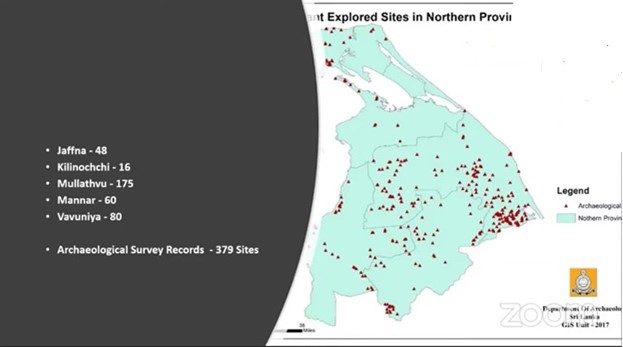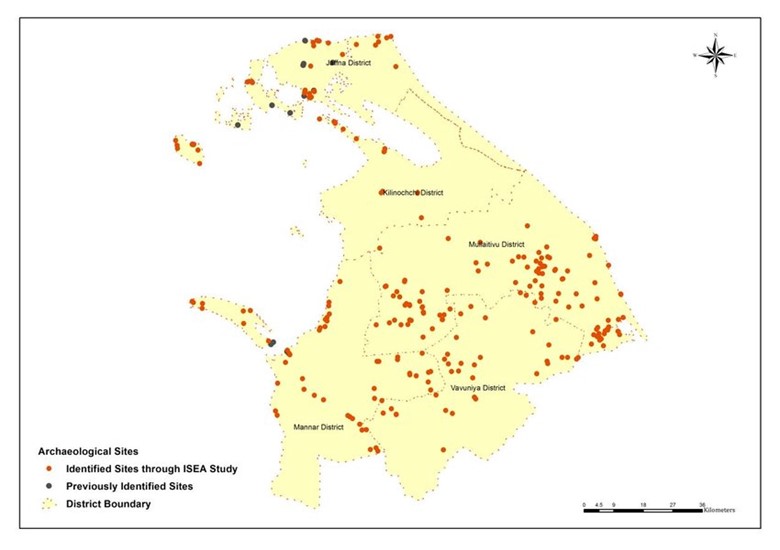BUDDHIST CIVILIZATION IN THE NORTH AND EAST OF ANCIENT SRI LANKA Part 3
Posted on December 25th, 2021
KAMALIKA PIERIS
revised 26.12.21
The North and East was a part of the Buddhist civilization of the Anuradhapura kingdom. It was part of the Rajarata and came directly under the rule of the Sinhala king. Inscriptions show that Abhayagiri had monasteries outside Anuradhapura. Abhayagiri had monasteries at Kantarodai in Jaffna, and at Nedunkerni and Ottimalai in Vanni.
With the rise of the Tamil Separatist Movement, Buddhists feared for the Buddhist ruins in the north and east. They wanted them listed and shown on maps. Several persons then started to list the Buddhist sites in the north. M. H. Sirisoma, Asst. Archaeological Commissioner prepared a map of Buddhist sites in 1963. This was much valued and greatly used. It is still cited as a pioneer contribution.
In 1983, Cyril Mathew prepared a 167 page document, titled An appeal to UNESCO to safeguard and preserve the cultural property in Sri Lanka endangered by racial prejudice, unlawful occupation or willful destruction.” it is a privately published monograph, carrying the address. Barnes Place, Colombo 7.”
Cyril Mathew’s book has a large map which shows the location of the Buddhist sides of the north and east. Map lists 21 places in Jaffna, 4 in Mannar, 105 in Vavuniya and Mullaitivu.’ The book also contains information on 24 selected sites, with supporting documents, showing the destruction of these Buddhist monuments. Among the monuments destroyed he lists Kurundanmalai where in 1981 there was an attempt to turn the image house into a Hindu kovil. A siripatula found there was used as a base to light camphor.
Further, the stupa at Nellikulam in Vavuniya had been leveled and cemented and a trident placed there. A Hindu kovil has been constructed in the vihara premises at Mohantankulam in Vavuniya. The entire area, including ruins has been fenced in and turned into a large cattle shed, said Cyril Mathew. A Hindu kovil was to be set up at Samalankulam in Vavuniya.
Cyril Mathew’s book ends with a set of photographs showing the damage caused to several Buddhist monuments in the north and east. The photographs include a wantonly damaged Buddha image from Etambagaskada. Cyril Mathew acknowledged the support of several others in preparing this document. He speaks of the support and cooperation he received from colleagues, friends and well wishers. (See last page)
Ellawela Medhananda explored and wrote up his findings on the north and east starting in 2003 and continuing into 2013. He provided maps of the sites he visited.
In 2007, the periodical Buddhist Times” provided a list of Buddhist sites in north and east. Jaffna had 21, Mannar had 4, Vavuniya and Mullaitivu had 104, Trincomalee had 81, Batticaloa had 22, and Ampara had 41. A total of 274 sites, said Buddhist Times. Kantarodai in Jaffna was a large area, now it is reduced to a small area, Buddhist Times” added.
In November 2010, Sri Lanka Archeological Society presented a talk by Muditha Karunamuni on exploration and conservation of archaeology sites in north and eastern provinces. North and east is packed with Sinhala Buddhist monuments, he said and showed maps to indicate this. .Muditha observed that some Buddhist remains were deliberately destroyed. These included Etambagaskanda, and Kandikulam in Vavuniya. Delft had Buddhist ruins including a chaitya. As long as navy was at Delft these ruins would be safe, Muditha observed.
In 2010 the Department of Archaeology initiated a survey of the Buddhist sites in the north. Vasana Premachandra of the Department of Archaeology gave a talk before the Archaeological Society in 2019 on the findings of this project. In July 2020, Vasana, together with Kalpa Asanga, who had led the team in Vavuniya, gave an expanded version of the talk to the Institute of Archaeology and Heritage Studies, Colombo. That talk can be viewed on https://www.youtube.com/watch?v=zNeaiDsTBoY
From these two talks, we learnt about the Buddhist monuments project carried out in 2010 by the Department of Archaeology in the north. In 2010, the Department of Archeology sent a team to the North, to map out the Buddhist remains in Mullaitivu, Kilinochchi, Vavuniya, Mannar and Jaffna. Their task was to find and list all the Buddhist monuments they found and bring those areas under the authority of the Department of Archaeology. The purpose was to protect these archaeological sites from possible damage by the development projects planned for the Northern Province.
The Department obtained a grant from UNDP and started work in 2010. The UNDP grant ended in 2014, but the project continued to 2015.The team paid 14 visits to the Northern Province, staying 10 days per month. We were unable to walk the full area of a site, as we should, said Vasana. The army did not allow us to do so. We were confined to the areas the army permitted us to go, but this included high security forested areas as well. However, they were able to cover 80% of Mullaitivu area and 60% of Vavuniya.
The team first looked at the 44 known sites, but more sites emerged and the project went on to discover a total of 379 sites. They found 48 in Jaffna 16 in Kilinochchi 175 in Mullaitivu 60 in Mannar and 80 in Vavuniya.

We were the first civil unit to go into these areas after the war, Vasana said. It was very difficult. There were no local informants. Also the Department of Archaeology had not been active there for the last 30 years. Therefore, the team did not follow the usual procedure of working with the administrators serving in that district.
Instead, they worked in consultation with the army, who were firmly in control in the north. The army had three regional commands at Jaffna, Wanni and Mullaitivu. The archaeological team worked closely with the brigades under these Commands. The brigades consisted mainly of infantry battalions. The army had been very supportive. They made sure that the team was comfortable. The army had given up their rooms to the archaeological team and had built toilets for the female members. The navy and the civil arakshaka Balakaya had also helped. .Vasana and Kalpa expressed grateful thanks to the armed forces for their support.
The army and the archaeological team had worked together very harmoniously. There was much dedication and cooperation on both sides in executing the project. The army was also very helpful in the actual search. ’They would call us to come and look at the things they had found.’
Once the team had identified a site as a Buddhist archaeological site, they erected an Archaeological Department column there. This concrete column was very heavy, but officers carried it willingly. The team also set boundary stones and put up a board announcing in all three languages that the place was now an archaeological site. Back in Colombo, the team recorded their findings in three ‘district books’. They also had a large collection of photographs.
The team prepared maps containing the location of these sites. These maps were given to the other Departments to be included in their maps of the north. The locations were also put on the Department website https://archaeologysl.maps.arcgis.com/home/index.html. Wont these ruins disappear in ten years, now that they have been identified,” asked the audience. Vasana replied ‘that is why we have put them on the website, so now they cannot do away with them’.
The team obtained GPS positions for all the sites. The team was asked, when you give GPS locators won’t that help people to destroy these places. The team replied that most of these places are in high security forests or high security zones, also we have not publicized the GPS locations.
Vasana said , in answer to a question from the audience ,that the Department did not take the Sangha along to inspect sites. If we took them that could have created problems”. The only bhikkhu who had explored the area successfully was Ellawela Medhananda
The team found various types of evidence in these Buddhist sites. The team found a ketarama with brahmi script at Konagaharayan kulam and Vedikumarimalai cave temple. They found a karanduwa of a stupa at Marandankurni, a huge vihara complex, with stupa mound at Sonanochcha kulam, a siripatula at Periyamadu Muttumani Ambal kovil, a pabbata vihara at Mutiyankattakulam and a guard stone at Kokilai. In Mullaitivu, the ruins spread over large areas. There were remains of stupa and many image houses. The Buddhist sites found in Mullaitivu and Mannar were mainly Anuradhapura period , some were early Anuradhapura, some middle Anuradhapura .
In Mullaitivu the team found 175 archaeological sites, but not all were Buddhist, some were pre-Buddhist. The team found 44 huge ( ‘visala’) monasteries , 34 sites where the Buddhist ruins could be identified and another 55 where they could not identify what the function of the Buddhist ruins was.
Here are some of the findings at Mullaitivu. Ambakamun ruins had a standing Buddha statue, stupa mound and ruins of monastery. At Andankulam the team found Buddhist ruins in 4 places there was a stupa 6 meters tall circumference 20 meters, a Buddha statue and asanaya. There was a monastic complex at Janakapura.
Kachchidu had a large ruin complex, with Buddha statue and asana. Kalvilan was a monastery.
At Kalvilan, villagers had built houses over the whole monastic site using material from the Buddhist ruins. Various religious objects were found in the houses such as siripatula gala for washing clothes near the well. The team spoke to the villagers and persuaded them to part with these religious objects. Ruins were found in a paddy field at Kalvilan.
Kanyarkovil had Buddhist ruins. At Kiribbanwewa there was a seat and a cave with ketarama . The site also had two pre-brahmi inscriptions. Koddiyamalai site held two caves with ketarama . There has been a huge monastery at Kokavil. A complete guardstone was found .. Rupavahini is there now. Komalamunai had a huge stupa mound; it has been a monastic complex.Kumbakarna malai also appears to have been a huge monastic complex. There were lots of ruins.The team thought this was probably Kumbaselaka vihara. Kurundavashoka vihara in Komalamunai site had a moonstone and steps.
Mutiankattikulam has been a huge monastery. The team found a korawakgala and asana there. A stupa had emerged in the wewa when the water went down. The Oddusuddan area had lots of Buddhist ruins spread about the area, as at Keridamadu, Kachchilamadu, and Muniyan Kaddikulama. Materials from Buddhist ruins were used for the Oddusuddan kovil.
Buddhist pillars were seen beside the Sivapuram Sri Malai Kovil also stone edict dated to 8 to 10 AD which has been published. .‘Vannammaduva had a complete Buddhist statue in Samadhi, the army took it and it is now kept in the army camp.
Buddhist sites were found in several places in Mannar. Maligapitti had lots of ruins with a stupa mound. Place is surrounded by houses. A Buddha statue was found near Murungan, also a stupa in a banana plantation. Buddhist ruins were found near Murungan hospital including siripatula, an inscription and stone columns. The inscription and siripatula were used for patients to sit on. There were Buddhist sites at Mardamadu Pudalpitti, Neeravi kulam and Pokkaravanni .A. Buddha statue was found at Koviyamadu. The army had placed it inside a hut and were looking after it.
The team found 6 firmly established monasteries in Mannar. They were monastic complexes. They belonged to the Anuradhapura period, but the team did not have the time to accurately identify which Anuradhapura period they belonged to. The large complexes were always near water. The team also found a vast number of inscriptions in Mannar which were not known earlier. The script used in the northern inscriptions was the same as the script found in the southern inscriptions.
In 2016, the Integrated Strategic Environment Assessment for the Northern Province of Sri Lanka (ISEA-North) 2016-2017 prepared a map of the Buddhist remains in the north.

Source https://www.researchgate.net/figure/17-Archaeological-sites-in-the-Northern-Province-Based-on-data-provided-by-the_fig14_340451884 (2016) CONCLUDED